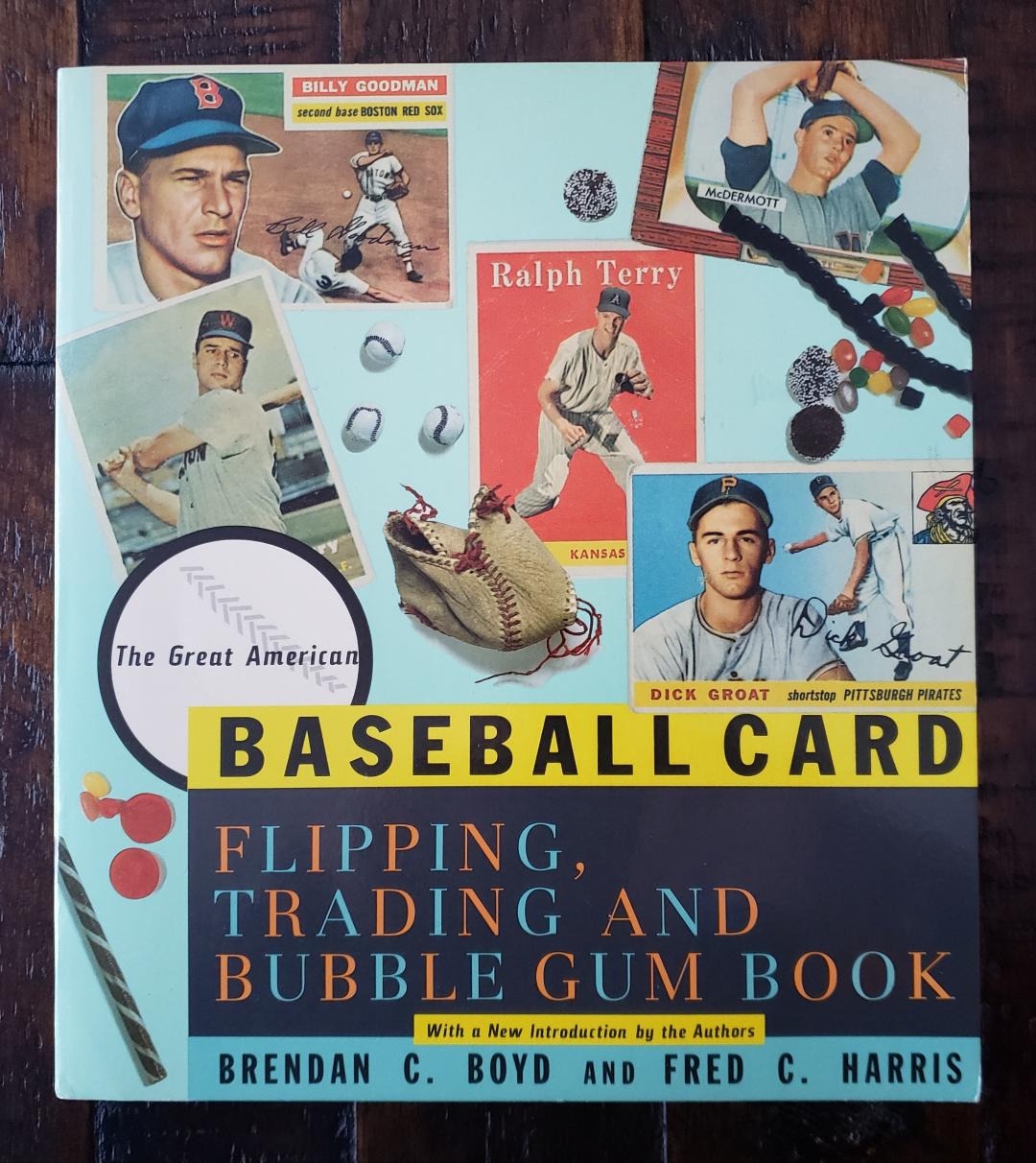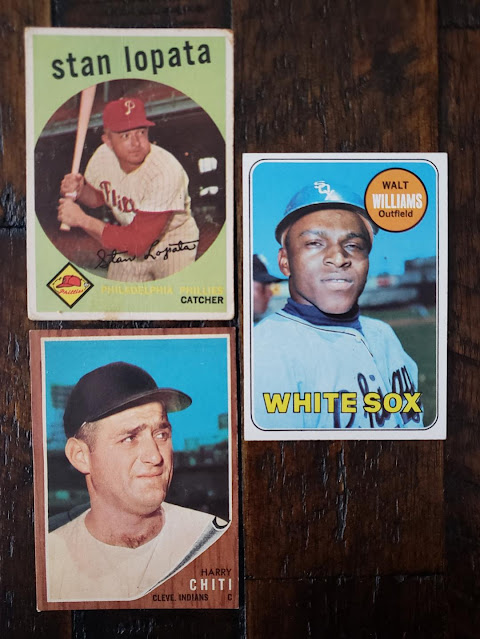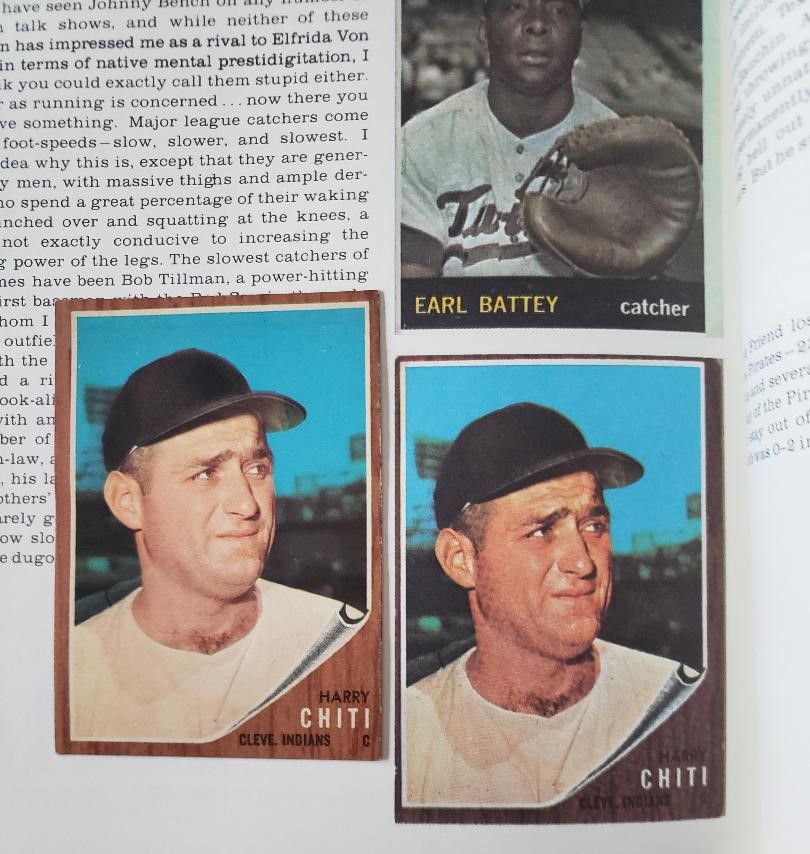The topic of The Great American Baseball Card Flipping, Trading And Bubble Gum Book came up again on the socials today.
It seems to be a repeated topic around this time of year. Maybe people received that book for Christmas as kids, or want it for Christmas. I got it for Christmas about 12 years ago.
So, I thought I'd trot out the book again and update a post from two years ago, when I went through the book to find how many cards in my collection are showcased in the book.
Two years ago I determined there are 243 card images in the book that I have. (I also added the five cards on the front to make 248 but those cards are repeated inside, so that was an error on my part). And I determined I had 48 of the cards shown.
I went through the book again today and totaled 50 cards in the book that I have, so I've added two since.
However, I'm pretty sure that I didn't own these three since I did the count the last time. So either I over-counted the last time or I'm under-counting now.
I was able to determine on the blog when I landed the Lopata (June) and the Williams (July), but not the Chiti. But anyway, I have 50 and that's 21 percent of the images in the book.
When you have cards from that book, you can do fun stuff like pair up your card with the book card.
My Lopata has a great big north-south crease through the center and possibly a blood stain on the bottom. Boyd and Harris would be quite proud.
Let's see what the authors said about Lopata:
"Stan Lopata was a good, big catcher with the Phillies, who hit out of a peculiar crouching hitting stance that presented a very difficult target for a pitcher because it effectively reduced the strike zone. As much as pitchers complained to umpires about Stan's stance being illegal, however, the stance didn't do Stan much good, except maybe in 1956 when he hit 32 homers and 33 doubles."
The card illustrates Stan's stance nicely.
Here's the Harry Chiti match. My card is lighter than the version in he book.
The write-up on Chiti:
"... and Harry Chiti, a reserve catcher with any number of teams over a period of any number of years who looked like everybody's brother-in-law, and played like him too. Fortunately for Harry his lack of speed was not as noticeable as was the others' because he was such a lousy hitter that he rarely got on base. The only time you really noticed how slow he was was when he was trotting back to the dugout after striking out."
As the kids say: "Savage".
"And yes, Virginia, "Walt Williams" had no neck. And his legs weren't particularly long either."
Those were the last two sentences in a snippet that covered several different players. But the introduction to that passage interested me and made me realize how long ago this book was written (its 50th anniversary is this coming year).
"Someday" has come and gone. There's still nostalgia for the '70s -- I'm a prime example -- but the peak era for that kind of nostalgia was during the 1990s ("That '70s Show," etc.). Today you've got people who never heard of Franco Harris.
(By the way, there's a couple misspellings in that series of names).
So, that was just an update of an old post, but I have something completely new about the book for you, too.
I got interested in what card sets were shown in the book the most. So I counted them all. This is what I found:
1940 Play Ball - 3
1951 Bowman - 13
1952 Bowman - 3
1952 Topps - 32
1953 Bowman - 2
1953 Topps - 2
1954 Bowman - 9
1954 Topps - 8
1955 Bowman - 1
1955 Topps - 11
1956 Topps - 17
1957 Topps - 14
1958 Topps - 26
1959 Topps - 12
1960 Topps - 6
1961 Topps - 11
1962 Topps - 11
1963 Topps - 30
1964 Topps - 11
1965 Topps - 7
1966 Topps -2
1967 Topps - 2
1968 Topps - 2
1969 Topps - 3
1960 Topps football - 1
(There are also four other tobacco-era cards pictured, but I didn't have time to figure out what the heck they were).
1952 Topps has the most with 1963 Topps up there, too. 1958 Topps is third. I don't know the reasons for this. Maybe those were the years the authors collected the most cards?
I do know it means I probably won't be accumulating too many more examples from the book, as my interest in the three sets that are shown the most is much lower than some of the other '50s and '60s sets.
So there you are, that's something new about TGABCFTABGB. Although I'm guessing someone has probably already done this before, too.
This book still makes an excellent Christmas gift.






Comments
The inside page had a dedication to some who had purchased the book at The Baseball HOF!! !! So I still have that copy but would love to get the 70's paperback again and relive my informative years of card collecting.
It is a dream of mine to collect all the cards in the book. Which in most ways is easier than ever before in the life of this book. But in other ways, it is also more difficult than ever before, as there are a few quite expensive cards in that book and I don’t anticipate attempting this project.
In some ways the book is the first BASEBALL CARD BLOG.